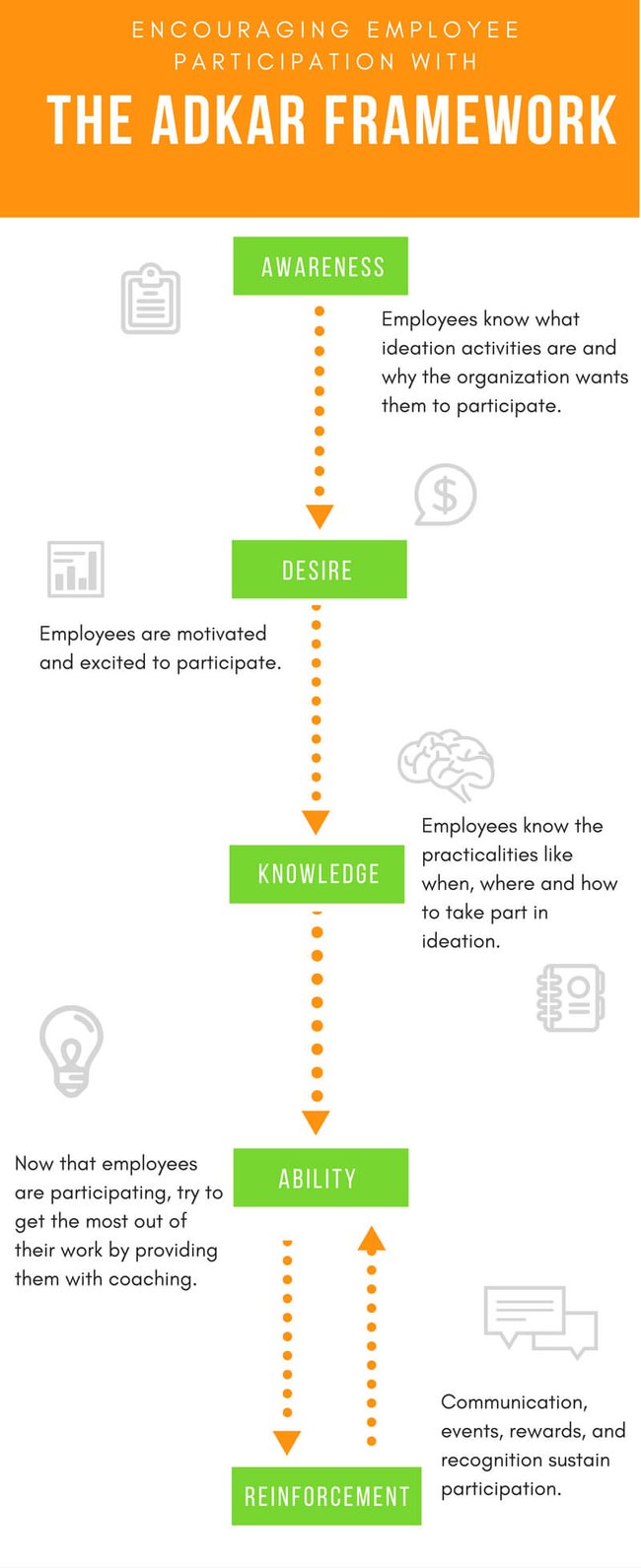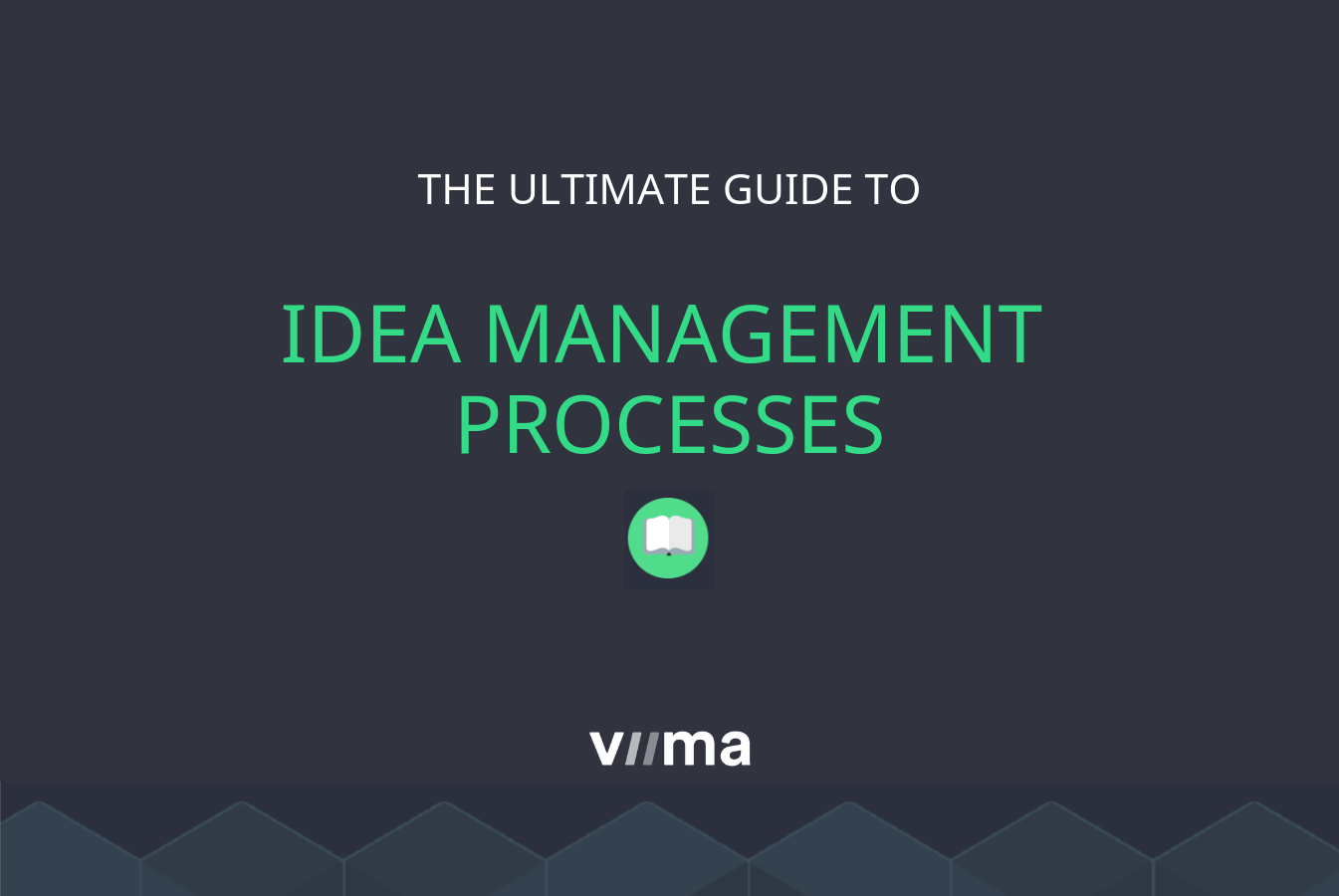Encouraging Active Employee Participation – The ADKAR Framework
Often just giving the opportunity and tools to participate in the company’s ideation activities ensures active employee participation.
Almost always there’s going to be a good amount of initial enthusiasm and excitement around the initiative.
Having said this, usually that initial enthusiasm won’t last if you don’t put in the work to systematically sustain that participation in the long run.
In the organizations that have started using Viima during the last few years, the amount of submitted ideas from employees usually surpasses the number for the entire last year within weeks thanks to the increased transparency and ease of participation.
However, it is after this initial rush that we see the paths of the best companies diverge from those who aren’t as successful. The difference largely comes down to factors: the management and execution of the ideas already in the process, as well as facilitating and nurturing the internal community around these activities.
While simple on paper, maintaining a positive energy in the activities and facilitating this community isn’t always easy and takes a lot of hard work. This post will introduce you to the ADKAR framework that you can use for this process, along with some practical tips for making sure that employees are actively participating in ideation activities to drive the business forward.

Table of contents
The ADKAR Framework
ADKAR is a change management framework that focuses on how change happens on the individual level. This means that the framework describes the different stages to take into account in the change process, which in the context of this post is activating employees to participate in ideation.
The ADKAR framework is especially well suited for this context as, unlike many other change management frameworks, it stays on a practical level instead of considering only managerial or organizational viewpoints.
Nevertheless, ADKAR is still quite a generic change management framework so this post focuses on explaining it and applying it to our context.
Awareness
There are many reasons for the introduction of virtually anything new always causing some resistance to change and this case is no different. This resistance can, however, be managed, at least partly, by first creating awareness and then responding to that critique in a constructive manner.
Of course, unless employees become aware of the company’s aspiration for employee ideation, as well as the rationale behind that, they are very unlikely to do much in that regard.
In practice, building awareness means that all employees should know the answers to at least the following questions:
- What exactly is it that I’m supposed to ideate about?
- Why should we be doing this?
- What should be the concrete output of these activities?
- What would happen if we employees don’t participate?
- What’s in it for me?
For the most part, the answers vary a lot based on your unique requirements for the process. The concrete output could, for example, be identifying and prioritizing current challenges customers are facing, process improvement suggestions or perhaps new business opportunities waiting to be piloted.
In regard to the benefits the employees, you should highlight the indirect benefits in addition to the concrete rewards. For example, this is a place where the employees can find solutions to challenges they’re struggling with on a daily basis, making their work much more productive and enjoyable in the future.
Desire
After creating awareness, the best way to proceed is by building up the desire for participation. If you don’t build that, you’ll have a hard time sustaining active employee participation in the long run. For that to happen, people need to be enthusiastic, motivated, and eager to engage and you can’t really force that if people don’t desire that.
This is usually one of the more challenging stages due to people being motivated by different things. Some are motivated just with the opportunity to work on their own ideas, some might be looking more for acknowledgment and status, whereas others by career progression and money.
For example, HubSpot has been running regular idea contests between their employees. They’ve arranged these in a very clear and systematic way, but pretty much the only reward has been the chance for the authors of the winning ideas to take part in the implementation of that idea. Offering this kind of meritocratic career progression is usually a highly motivating reward for employees as they get to work on something they really like and take pride and ownership of the project.
To assess the motivation and engagement for ideation in your organization you can, for example, ask yourself:
- What are the reward systems and mechanisms in our organization?
- Do they work? Are some mechanisms better than others?
- What motivates our employees? Are the motivators similar from person to person?
- How would they like to recognized?
- What are some of the typical development suggestion regarding job satisfaction from our employees? What kind of suggestions are they?
With the help of these questions, you can assess and identify the varying sources of motivation in your company and map your employees on the Motivation-Hygiene Matrix, which again helps you choose the correct factors for building desire in your organization. You can check our earlier blog post on the sources of employee motivation for more on this process.
Knowledge
Desire and excitement can quickly turn into frustration if people are trying to participate but don’t know what to do.
The Knowledge Stage is thus about the practical training and information on how ideation actually happens in the organization. This means that employees know how the tools, processes, and systems work and what their managers expect them to do on a daily basis.
- Do employees know what ideation tools in use are?
- Do they know how to access and use these tools?
- Do they know when to use these tools and where the activities fit in the day-to-day practices and processes of theirs?
For example, if a customer comes up with an idea, development suggestion or a clear problem in your product that they talk about to one of your employees, the employees could be instructed to always write it down and input the idea to your idea management system (that can be found from your intranet) right after the meeting.
Clear policies on when and how to write ideas down always makes things a lot easier for everyone.
Ability
Abilities only come into play once you’ve actually gotten employees to participate. At this point, you’ll quickly see how the process starts to work in practice and learn which areas people have the most room for improvement with. The abilities of employees can naturally be improved by coaching, mentoring and training them.
Typical areas for improvement that we’ve identified in many of the companies we’ve worked with are the employees’ abilities for evaluating the business potential, strategic fit, and feasibility of their ideas as well as their ability to provide constructive feedback for each other.
To appraise or improve the abilities of your employees to apply their knowledge to ideation activities, you’ll get pretty far just by asking these two questions:
- If you look at the previous suggestions by your employees, what are the areas they have the most challenges in and is there something you could do to improve the situation?
- Have you made sure that managers take the time to a) spar existing ideas forward and b) coach their team to develop their skills in critical thinking?
Reinforcement
If the rate of participation seems to plummet when the initial enthusiasm starts to fade, it just means that you haven’t been able to make participation a habit for your employees. Creating habits isn’t always straightforward and does take some time.
In essence, to make participation a habit, you first need to link it to the daily processes and everyday work of employees and then reinforce the participation to sustain the efforts and build a culture for continuous innovation. For more on this topic, you can read our previous post on creating habits.
In practice, this can, for example, be established with activities such as clear and continuous communication, frequent recognition and rewards, as well as special events. The idea is just to sustain the momentum for active ideation as long as it takes for active participation to become a part of your culture. When you communicate and show commitment, people will eventually respond.
The idea is to sustain the momentum for active ideation as long as it takes for active participation to become a part of your culture.
Some of the questions to ask yourself at this point are:
- How are people reminded of the need to make their efforts continuous?
- How do you maintain their motivation? Are you reiterating and communicating your points from the awareness and desire parts often enough?
- Are you making sure that their efforts aren't a) neglected altogether or b) in vain (≈ nothing happens for their ideas)?
- Is the participation truly tied in with the employees’ daily operations?
Those of our customers that have put in the continuous effort to make sure that the ideas of their employees aren’t neglected and that even terrible ideas are commented with the author being coached on their ideas, are the ones who’ve made huge progress on both the quantity and quality of the ideas.

Using the framework in practice
The biggest challenge with the ADKAR framework, just as with any other change management framework, is that people think of it as something you can just do once and then forget about.
In reality, it’s an iterative process that you have to repeat as many times as it takes. Nothing ever goes as you planned it would, least of all something like organization-wide participation that requires change from single employee.
We’ve seen that especially the ability and reinforcement stages are something that most organizations need to do at least a few iterations on before employees start to get it right.
If you’ve already introduced employee ideation activities but just aren’t seeing the level and quality of participation you’d like to have, take a step back and assess your current situation with ADKAR, then proceed with the actions relevant for whatever stage you’re currently at.
Take a step back and assess your current situation with ADKAR, then proceed with the actions for the stage you’re currently at.
So for example, if employees aren’t participating after the initial enthusiasm has faded, you probably need to work on your reinforcement practices. If, however, the activities never really got going in the first place, chances are that you need to go back and work on the awareness and desire stages.
When you use the framework periodically to do a lightweight current state analysis like this, you’ll automatically focus your efforts on the right things.
When you do that and are communicative, emphatic, thick skinned, and passionate about the cause, you have a solid foundation to build the participation on.
At this point, you just need to make sure that something really comes out of all of these ideation activities. If you haven't yet, we'd recommend you to take a look at our guide on idea management processes for more on that.




